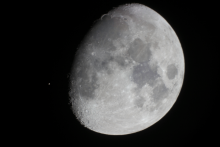Listen to today's episode of StarDate on the web the same day it airs in high-quality streaming audio without any extra ads or announcements. Choose a $8 one-month pass, or listen every day for a year for just $30.
You are here
Moon and Aldebaran
All stars are big. But there’s “big” and then there’s big. Consider the Sun and Aldebaran, the “eye” of Taurus, the bull. The Sun is big as stars go — probably in the top 10 percent of all stars. Yet it’s a mere plaything compared to Aldebaran.
The Sun is 865,000 miles in diameter — more than a hundred times the size of Earth. But Aldebaran is more than 40 times that diameter. And when you convert those measurements to three dimensions, the comparison is astounding: Aldebaran is about 85 thousand times the volume of the Sun. To put that in perspective, if the Sun was the size of a green pea, Aldebaran would be bigger than a beachball.
Aldebaran is so much bigger than the Sun because it’s past the end of its “normal” lifetime. Changes in its core have made the core millions of degrees hotter. The extra energy pushes the surrounding layers of gas outward, making Aldebaran puff up to giant proportions.
And it’s not through expanding just yet. Eventually, it’ll get about twice as wide as it is now. After that, though, it’ll quickly slough off its outer layers, leaving only its hot but tiny core — a white dwarf.
The Sun will puff up when it reaches the end of its normal lifetime as well — in several billion years.
In the meantime, look for Aldebaran quite near the Moon tonight. The bright orange star will stand close to the right of the Moon as they climb into good view, around 10 p.m., and a little farther below the Moon at dawn tomorrow.
Script by Damond Benningfield




